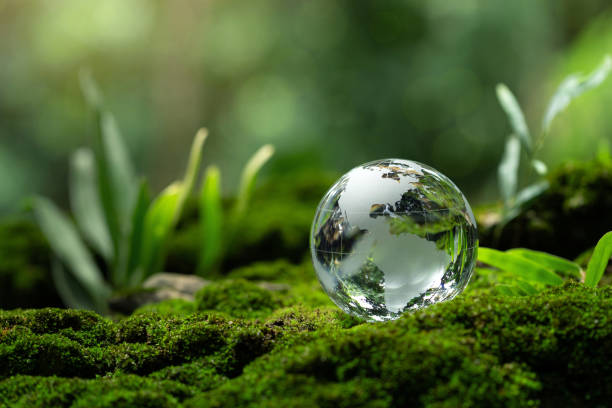Life on the earth is based on the environment. It covers all of the surrounding air, water, soil, plants, animals and natural ecosystems. A healthy environment supports life by offering the necessary resources to support life through clean environment, fresh water, fertile soil and biodiversity. Yet, our environment is seriously stressed due to the rapid industrialization, deforestation, pollution and climate change. Environmental conservation and reconstruction has ceased to be a preference but a need to survive.
What is the Environment?
Environment is a word used to refer to the surrounding natural world in which we exist. It comprises the living parts (plants, animals, microorganisms) and the non-living parts (air, water, land, climate). The environment is segregated into:
Natural Environment: Forests, rivers, oceans, mountains, deserts, and wildlife.
Built Environment: Human constructions including cities, industries and roads.
Social Environment: Human interactions, culture, and communities.
Collectively, these factors come up with the conditions that support life and determine the quality of human existence.
Importance of the Environment
Supports Life
The environment gives air, water, food and shelter or the fundamentals of life. The absence of it would be fatal.
Maintains Ecological Balance
Wildlife, forests, and oceans keep the ecosystems in check and there is a natural flow of carbon, nitrogen, water cycles.
Economic Resources
Natural resources such as minerals, oil, timber, and water fuel industries, agriculture, and global trade.
Cultural and Aesthetic Value
Mountains, rivers, and sceneries have strong links with human culture, spirituality and recreation.
Climate Regulation
Forests capture carbon dioxide, oceans maintain temperature and ecosystems become natural cushions against disasters.
Current Environmental Challenges
Climate Change
Due to greenhouse gas emissions, global warming causes an increase in the temperature, melting glaciers, and unpredictable weather patterns.
Deforestation
This is because the clearing of forests to make agricultural lands, urbanization and logging activities deplete biodiversity and contribute to carbon emissions.
Pollution
Air pollution from vehicles and factories, water pollution from industrial waste and pesticides contamination of the soil are significant threats.
Loss of Biodiversity
There is a destruction of habitats, poaching, and climate change that endanger the survival of many species of both plants and animals.
Waste Management
Pollution by plastic and poor disposal of waste damages aquatic life and pollutes the soil and water.
Overpopulation and Overconsumption
Increased populations lead to strain on resources as populations pressure the ecosystems.
Human Impact on the Environment
Man has made himself the most powerful agent of the environment:
- Greenhouse gases are augmented through industrialization.
- With urbanization, the green spaces are reduced.
Common agricultural activities include the use of pesticides and fertilizers that build up in the soil, destroying its health.
The use of fossil fuel fuels quickens global warming.
- Deforestation devastates the natural habitats and it diminishes oxygen supply.
However, these measures have long-term dangers on human health and existence even as they provide short-term advantages.
The Role of Conservation
Environmental conservation refers to the protection, preservation, and sustainable management of natural resources. Key approaches include:
Sustainable Development
A balance between economic development and conservation of the environment guarantees resources to be used by future generations.
Afforestation and Reforestation
Trees would replenish ecosystems, absorb carbon dioxide and curb soil erosion.
Wildlife Protection
Endangered species are conserved through conservation programs and sanctuaries in which they are being protected against extinction.
Renewable Energy
Replacement of fossil fuels with solar, wind and hydropower minimizes pollution and greenhouse gas emissions.
Reduce, Reuse, Recycle (3Rs)
Reduction in the production of waste materials and recycling of materials reduce the strain on natural resources.
Water Conservation
Precipitation systems, effective irrigation, and less use of water waste conserve freshwater.
Global Environmental Agreements
Global partnership is essential in fighting environmental issues. The major initiatives would include:
Paris Agreement (2015): An international agreement to cut global warming to less than 2degC.
Kyoto Protocol (1997): A treaty on greenhouse gas emission reduction.
United Nations Sustainable Development Goals (SDGs): A framework to balance environment, economy and social well-being.
Convention on Biological Diversity: A treaty to protect biodiversity all over the world.
Role of Technology in Environmental Protection
Technology has a significant role to play in environmental problems:
Clean Energy: Electric vehicles, solar panels and wind turbines decrease carbon emissions.
Smart Cities: Technology application in enhancing energy efficiency, waste management and transport.
Artificial Intelligence (AI): AI can be used in tracking deforestation, wildlife, and forecasting climate conditions.
Water Purification Systems: The innovations can be used to give clean drinking water in the contaminated areas.
Recycling Technologies: With new recycling technologies, plastic waste can be recycled and a circular economy can be encouraged.
Individual Responsibility Toward the Environment
Any person can become a difference-maker by becoming an eco-friendly person:
- Reduce plastic use and switch to biodegradable products.
- Conserve electricity and water at home.
- Reduce carbon footprints by traveling by the use of public transport, bicycles, or electric vehicles.
- Plant trees and support green initiatives.
- Attend community clean-up activities.
- Support eco-conscious companies and policies.
When multiplied by millions little steps make a huge constructive difference to the environment.
Environment and Health
Human health is directly related to the status of the environment. The result of poor air quality is respiratory problems, water pollution results in illnesses, and harmful chemicals affect general health. A healthy environment with no pollution minimizes the chances of epidemics and enhances physical and mental health.
The Future of the Environment
Unless immediate interventions are undertaken, the rate at which the environment is degrading will only increase. Nevertheless, the future is promising provided that humankind adopts sustainable practices. The next decades may see:
- Widespread adoption of renewable energy.
- Expansion of green jobs and eco-friendly industries.
- Stricter global environmental laws.
- More eco-conscious consumer behavior.
- Technological breakthroughs in carbon capture and recycling.
The future of the environment lies within world collaboration, effective policies, and involvement of each and every person.
Conclusion
The environment is the life line of humans and other living creatures. It supplies the much needed resources, controls climate, and aids biodiversity. Nevertheless, its stability is at stake because of rising poverty and pollution, global warming, and unfriendly practices. Environmental conservation is a social duty of practice–governments, corporations, and citizens should combine their efforts to have a better, and healthier planet. We can save the environment to be used by the future generation by taking sustainable practices, making investments in renewable energy and by observing natural ecosystems. The decisions that we make today will shape the type of world our children will be inheriting tomorrow.







